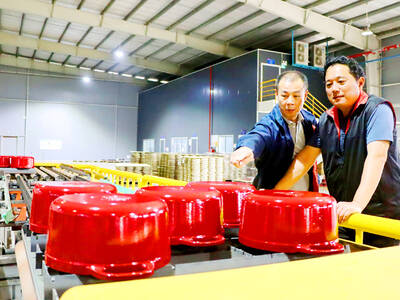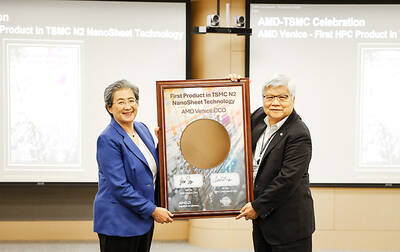The level of joblessness last month climbed for the fourth straight month to 4.4 percent, the Directorate-General of Budget, Accounting and Statistics (DGBAS) said yesterday, adding that the nation’s unemployment rate might improve this month based on historical experience.
The rate of unemployment — an indicator of slowing economic performance — last month marked its highest level since August last year and was up from 4.31 percent in July, the agency said in its monthly report.
The seasonally adjusted unemployment rate, a more reliable indicator of the long-term trend, was up 0.04 percentage points from the previous month to 4.29 percent last month, the report said.
“The seasonal effect continued to be the main factor that pushed up the jobless rate last month,” DGBAS deputy director Chen Min (陳憫) told a press conference.
A majority of the college graduates entering the labor market have done so in the past few months, but some have not received job offers yet, which is why unemployment has continued to climb, Chen said.
The slowing economic sentiment was another factor that helped drag down the labor market as a conservative attitude among employers made them less likely to recruit personnel, including first-time jobseekers, Chen added.
The latest data showed that 502,000 people were unemployed last month, an increase of 12,000 from the previous month, with the number of first-time jobseekers failing to find employment rising by 8,000.
The increase was also reflected in growing youth unemployment, with joblessness among 15-to-24-year-olds rising 0.65 percentage points from July to 13.61 percent last month, its highest level this year, the report showed.
However, Chen said the historical trend in the rate of unemployment showed that the figure usually rose to its highest annual level in August and further improved in the following months.
This would indicate that this month’s jobless rate remains an important indicator to evaluate the current national labor market situation, Chen added.
Tony Phoo (符銘財), a Taipei-based economist at Standard Chartered Bank, said that he expected the unemployment rate to show an improvement from this month, as exports return to a modest level of growth in the fourth quarter.
“Regardless of the impact of the seasonal effect, the employment situation has not improved over the past three months,” Phoo said in a telephone interview.
Phoo expected the unemployment rate could drop to between 4.2 percent and 4.3 percent by the end of this year, with job openings offered by the service sector and the financial industry leading the trend.
The DGBAS also released the latest salary data yesterday, which showed that national monthly salaries averaged NT$37,435 (US$1,270) in July, up 1.63 percent from a year ago.
However, when bonuses and other forms of compensation are included, the average monthly remuneration package showed a 0.44 percent markdown from a year earlier and stood at NT$42,535 in July, the data showed.

UNCERTAINTY: Innolux activated a stringent supply chain management mechanism, as it did during the COVID-19 pandemic, to ensure optimal inventory levels for customers Flat-panel display makers AUO Corp (友達) and Innolux Corp (群創) yesterday said that about 12 to 20 percent of their display business is at risk of potential US tariffs and that they would relocate production or shipment destinations to mitigate the levies’ effects. US tariffs would have a direct impact of US$200 million on AUO’s revenue, company chairman Paul Peng (彭雙浪) told reporters on the sidelines of the Touch Taiwan trade show in Taipei yesterday. That would make up about 12 percent of the company’s overall revenue. To cope with the tariff uncertainty, AUO plans to allocate its production to manufacturing facilities in

TAKING STOCK: A Taiwanese cookware firm in Vietnam urged customers to assess inventory or place orders early so shipments can reach the US while tariffs are paused Taiwanese businesses in Vietnam are exploring alternatives after the White House imposed a 46 percent import duty on Vietnamese goods, following US President Donald Trump’s announcement of “reciprocal” tariffs on the US’ trading partners. Lo Shih-liang (羅世良), chairman of Brico Industry Co (裕茂工業), a Taiwanese company that manufactures cast iron cookware and stove components in Vietnam, said that more than 40 percent of his business was tied to the US market, describing the constant US policy shifts as an emotional roller coaster. “I work during the day and stay up all night watching the news. I’ve been following US news until 3am

COLLABORATION: Given Taiwan’s key position in global supply chains, the US firm is discussing strategies with local partners and clients to deal with global uncertainties Advanced Micro Devices Inc (AMD) yesterday said it is meeting with local ecosystem partners, including Taiwan Semiconductor Manufacturing Co (TSMC, 台積電), to discuss strategies, including long-term manufacturing, to navigate uncertainties such as US tariffs, as Taiwan occupies an important position in global supply chains. AMD chief executive officer Lisa Su (蘇姿丰) told reporters that Taiwan is an important part of the chip designer’s ecosystem and she is discussing with partners and customers in Taiwan to forge strong collaborations on different areas during this critical period. AMD has just become the first artificial-intelligence (AI) server chip customer of TSMC to utilize its advanced

Six years ago, LVMH’s billionaire CEO Bernard Arnault and US President Donald Trump cut the blue ribbon on a factory in rural Texas that would make designer handbags for Louis Vuitton, one of the world’s best-known luxury brands. However, since the high-profile opening, the factory has faced a host of problems limiting production, 11 former Louis Vuitton employees said. The site has consistently ranked among the worst-performing for Louis Vuitton globally, “significantly” underperforming other facilities, said three former Louis Vuitton workers and a senior industry source, who cited internal rankings shared with staff. The plant’s problems — which have not